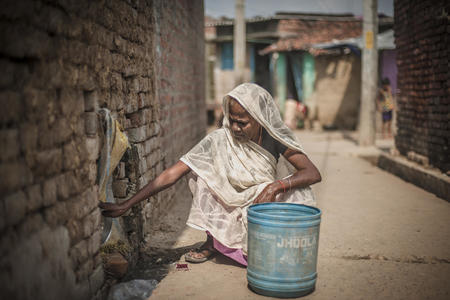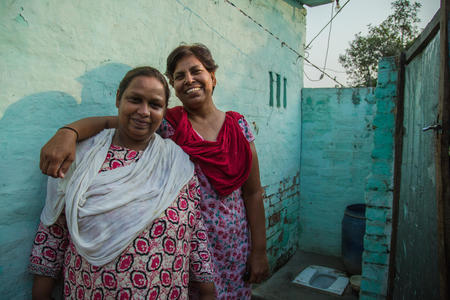India on the road to cleanliness!

Mamata Dash, Manager – Campaigns & Rights, Equity & Inclusion at WaterAid India, looks at the progress made since Prime Minister Narendra Modi announced his Swachh Bharat Mission to make India open defecation free by 2019, and asks what more needs to be done to achieve this ambitious goal.
It has been exactly one year since the Narendra Modi-led NDA government came to power with a stunning electoral victory. As the now not so new government gears up to highlight its achievements over the past year, let us try and objectively assess its performance at least in one area for which the new government is most known for, according to a recent poll.
Sanitation goes mainstream
On 15 August 2014, the Prime Minister, in his address to the nation from the ramparts of the Red Fort, set his government an ambitious target – to make India open defecation free by Mahatma Gandhi’s 150th birth anniversary on 2 October 2019. Subsequently christened the Swachh Bharat Mission (SBM), the campaign was launched with much fanfare by Narendra Modi on 2 October 2014 with the involvement of various celebrities. This spotlight was much needed as India faces almost herculean challenges on the sanitation front. The country still has more than 400,000 people engaged in manual scavenging, despite legislation prohibiting employment of anyone as a manual scavenger, and more than 50% of the population still continues to defecate in the open. In spite of many critics labelling SBM as old wine in a new bottle, and not very different from the erstwhile Total Sanitation Campaign (TSC) and/or Nirmal Bharat Abhiyan (NBA), one thing cannot be denied; SBM has managed to put the spotlight on the issue of sanitation through the endorsement from the Prime Minister.
But is there anything really new in SBM? The Mission has emphasised having separate approaches to urban and rural areas with rural being vested within the Ministry of Drinking Water and Sanitation (MDWS), urban now falling under the Ministry of Urban Development (MoUD), and school water, sanitation and hygiene (WASH) being given to the Ministry of Human Resource Development. Unlike in NBA, MNREGA has been delinked from the scheme and the subsidy amount has been increased. SBM has also been sharpened to focus on household and community toilets and school sanitation has been moved out of its purview. So, technically, the crisis of sanitation is now being dealt with by three ministries as nodal entities with an expectation that this division of labour will help in achieving the gigantic goal of making India open defecation free by 2019. In reality, however, there is a lack of coordination between the ministries and it is unclear yet on how the ministries will work together to overcome their overlapping sanitation challenges.
A numbers game
The mission to make India clean is expected to cost a whopping amount of ₹133,000 crore (more than £13 billion) over five years. However, the union budget slashed the allocation for SBM to ₹2,625 crore (£0.26 billion) from the ₹4,260 crore (£0.46 billion) allocated in 2014-15. The government states that the funding gap will be filled through a number of initiatives such as imposing a special Swachh Bharat Cess, activating the Swachh Bharat Kosh to tap corporate social responsibility (CSR) funds and getting states to find money from the increasing share of taxes and duties they will get from this year. But again, it is unclear how much money exactly these initiatives will be able to mobilise and how they will be managed. Another area of worry is the slash in the resources allocated for behaviour change. In India, the major challenge in the sanitation sphere is of getting people to use toilets once constructed and effective IEC programmes are necessary to make this change happen. But by allotting a meagre 8% of the money towards behaviour change initiatives on the ground that could be drivers for sustainable change, SBM could be setting itself up to fail like India’s previous sanitation programmes which couldn’t crack this critical step in any sanitation programme.
Over the past seven months, urban areas have been inundated with billboards, posters, TV and radio ads urging people to keep their surroundings clean and build toilets in their houses. While the government has spent a lot of money on this mass media campaign, it is as yet unclear if the campaign has managed to change people’s attitudes and approach towards sanitation. In the first nine months of 2014, about 2.5 million toilets were built and in the next three months about 2.4 million toilets were constructed – making it all of 4.9 million toilets built in the last year 2014-15. While that may seem like an impressive number, it pales in comparison to the gargantuan number of 111 million toilets that need to be built over the next four years to achieve total saturation under SBM. It is not clear how the jump from constructing just 5 million toilets per year to 26 million toilets a year will be managed and done.
To enable creation of organic demand for sanitation among communities, SBM places emphasis on creating foot soldiers termed as Swacchata Doots. While this frontline work force is much desired, only 8,890 Swachhata Doots have been identified so far against the 76,108 needed in urban areas. The rural scenario looks even worse. According to one estimate, 640,000 people will be needed from the panchayat to state levels to run this programme but the Mission is unclear on how this huge human resource crunch will be filled. The larger challenge is that of a lack of trained human resources at every level, which has led to sub-optimal performance of mandated bodies like the State Water and Sanitation Missions and District Water and Sanitation Missions. Without a real fillip to these, the supply side challenge wouldn’t be met.
The exponential increase in toilet construction in the last three months of the last financial quarter is also a serious cause of concern. A simple on ground verification of numbers uploaded on the MDWS website in a few areas found that many of the built toilets may not actually exist on the ground. This was revealed when organisations working on the ground went to provide the communities where such toilets were built with information on post-construction usage and instead found the toilets missing. This raises questions on the efficacy of the Mission’s monitoring systems and it is not clear if the current systems (that largely remain unchanged) have put in place an appropriate mechanism to address such challenges.
Time is running out
A lot of efforts go into translating the vision and mission of a massive campaign such as the SBM into real actions on the ground. For SBM to work, it is critical to concentrate on creating demand and responding to such demands without delay in release of funds. In addition, information on state, district and block-wide funds approved under SBM needs to be made easily available for people to know the annual plans and allocations for making their demands. While the expectation is on the communities to demand and build toilets and adopt new sanitation and hygiene behaviours, it is equally important for the state mechanisms, civil society and community organisations to be vigilant about any misuse of funds. It also needs to be working towards changing deep seated individual and social attitudes that lead to open defecation and other unhygienic practices among different communities. It is when such efforts come together that success stories such as Nadia district from West Bengal becoming the first district in the country to achieve open defecation free status can be achieved and celebrated.
Sanitation needs to be seen as a life cycle issue and hence providing sanitation facilities at work, education and other public spaces is important. This requires investing in the right place at the right time and in the most appropriate manner, for time is running out and the Mahatma’s 150th birth anniversary is not far away. SBM should not become yet another government scheme that makes the right noises initially only to die a quiet death once the spotlight moves away.
Mamata Dash is Manager – Campaigns & Rights, Equity & Inclusion at WaterAid India. He Tweets as @wateraidindia




